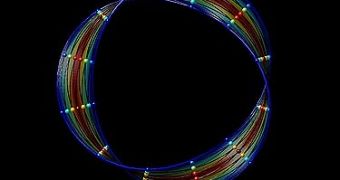Indeed, more than 2000 years later, Pythagoras seems to be right: not only there is pure and simple math in music, but the musical relationships can be interpreted into geometrical shapes! And three music professors from major world universities have the proof for it.
It looks like people have always been concerned with finding a relationship between mathematics and music; more than 2000 years ago, a Greek philosopher by the name of Pythagoras managed to intertwine music and math, creating the concept of "musica universalis", better known as the "music of the spheres", as it was called throughout the Middle Ages.
Due to the apparent perfection of the celestial bodies and their movements and relationships, Pythagoras and many more after him, considered that there must definitely be a kind of mysterious harmony in everything, with its proportions and ratios which can be seen as music.
Clifton Callender, Ian Quinn and Dmitri Tymoczko from, Florida State University, Yale and Princeton University, respectively have created a method they can use to reduce musical pieces to much simpler things such as mathematical relations. Professor Tymoczko initiated the new approach with pioneering research in this rather experimental field back in 2006, but nowadays, the trio finally published a more comprehensive study on this subject, now called "geometrical music theory", in the Science journal.
In a yet early stage, the new approach on music is still inexact and "cannot distinguish between Aerosmith from the Rolling Stones," as professor Tymoczko said. Though, this method has been capable to sense some differences between tracks coming from John Lennon and Paul McCartney, with a more modern character in Lennon's pieces and a more traditional music-making feel for the latter composer.
At the foundation of the geometrical music theory lies a method to categorize various sequences of notes, scales, chords and even rhythms into "families"; then mathematical structures have been assigned to these families, in order to become easy to put into point in complex geometrical spaces, ultimately generating shapes. The final representation is an "XY"-based bi-dimensional plane but some of the shapes are highly complex and in many cases they are really spherical, giving further evidence that the "music of the spheres" concept was not at all wrong.
In the end, as professor Tymoczko noted, this new approach to maths and music could very well become the foundation for new and unimagined way to experience the audio media, whether we're talking about new visualization tools or fantastic visual representations linked to musical acts.
We are just a few, but there are many of you, Softpedia users, out there. That's why we thought it would be a good idea to create an email address for you to help us a little in finding gadgets we've missed. Interesting links are bound to be posted with recognition going mainly to those who submit. The address is  .
.

 14 DAY TRIAL //
14 DAY TRIAL //